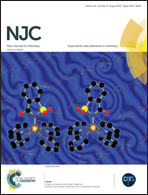Anti-leishmanial activity of Ni(ii), Pd(ii) and Pt(ii) β-oxodithioester complexes†
Abstract
New functionalized planar β-oxodithioester cis-chelate complexes, [M(L)2] (L = L1, methyl-3-hydroxy-3-(p-bromophenyl)-2-propenedithioate, M = Ni 1, Pd 5, Pt 9; L2, methyl-3-hydroxy-3-(p-fluorophenyl)-2-propenedithioate, Ni 2, Pd 6, Pt 10; L3, methyl-3-hydroxy-3-(naphthyl)-2-propenedithioate, Ni 3, Pd 7, Pt 11; methyl-3-hydroxy-3-(p-methoxyphenyl)-2-propenedithioate, Ni 4, Pd 8, Pt 12), have been synthesized and characterized by elemental analysis, IR, UV-Vis, 1H and 13C NMR spectroscopy; the structures of 2–4, 8 and 11 have been elucidated by X-ray crystallography. In all crystal structures, the metal has four-coordinate slightly distorted square planar geometry with a cis-configuration of the ligands. These complexes have been assessed for their use as anti-leishmanial agents; 7 and 9 showed impressive anti-promastigote and anti-amastigote efficacy with IC50 values of 0.59 ± 0.10 μg mL−1, 0.56 ± 0.10 μg mL−1 and IC50 0.85 ± 0.27, 1.99 ± 0.08 μg mL−1, respectively. Cytotoxicity assays on both compounds displayed toxicity on the promastigotes but less toxicity against RAW 264.7 cell lines at different concentrations. The Pd and Pt complexes exhibit luminescent characteristics in solution, originating from the intraligand charge transfer state.


 Please wait while we load your content...
Please wait while we load your content...